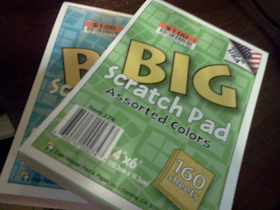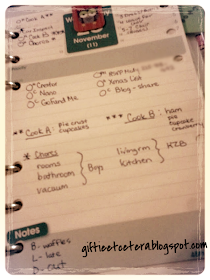Decide, completely based on the business of the holiday season, that your planner is, all at once, too big to carry and too little to write in.
2. Change bags 104 times.
After all, you need your hands free to shop, but your backpack/crossbody/messenger bag is too heavy with your planner in it.
3. Buy planner supplies on a whim, every single time you shop.
I got these at Big Lots for $1 for 160 sheets. I punched them (double punched) myself.
2. Change bags 104 times.
After all, you need your hands free to shop, but your backpack/crossbody/messenger bag is too heavy with your planner in it.
3. Buy planner supplies on a whim, every single time you shop.
I got these at Big Lots for $1 for 160 sheets. I punched them (double punched) myself.
4. Shove so many receipts into your planner, instead of your wallet with the nice pocket just for receipts, that your planner will not close.
#Overstuffed
5. Have at least one friend/family member ask you to keep track of a receipt because "you have a good filing system."
Don't have the heart to tell them that, right at this minute, that filing system consists of 2/3s of your kitchen counter.
(That actually happened to me this week.)
6. Buy two gifts for one person because you forgot to write it down the first time. Only realize when said recipient opens the SECOND identical gift.
(Happened to me last year.)
7. Lose your Elf on a Shelf.
8. Find your Elf on a Shelf while unloading the Christmas tree in front of your kids.
9. Get told by many, many Facebook friends how awful Elf on the Shelf really is, as if you didn't already know from the second night you owned him...when he forgot to move because you fell asleep!
Also, yes he is naughty. No, I am not ashamed of that. Yes, I understand that I am scarring my children for life.
#HideFriendFromNewsfeed
10. Spill an eggnog latte on your planner when you place your shopping bags on the table.
(Has not happened to me, thank goodness...yet.)
Etcetera.
(That actually happened to me this week.)
6. Buy two gifts for one person because you forgot to write it down the first time. Only realize when said recipient opens the SECOND identical gift.
(Happened to me last year.)
7. Lose your Elf on a Shelf.
8. Find your Elf on a Shelf while unloading the Christmas tree in front of your kids.
9. Get told by many, many Facebook friends how awful Elf on the Shelf really is, as if you didn't already know from the second night you owned him...when he forgot to move because you fell asleep!
Also, yes he is naughty. No, I am not ashamed of that. Yes, I understand that I am scarring my children for life.
#HideFriendFromNewsfeed
10. Spill an eggnog latte on your planner when you place your shopping bags on the table.
(Has not happened to me, thank goodness...yet.)
Etcetera.


















































